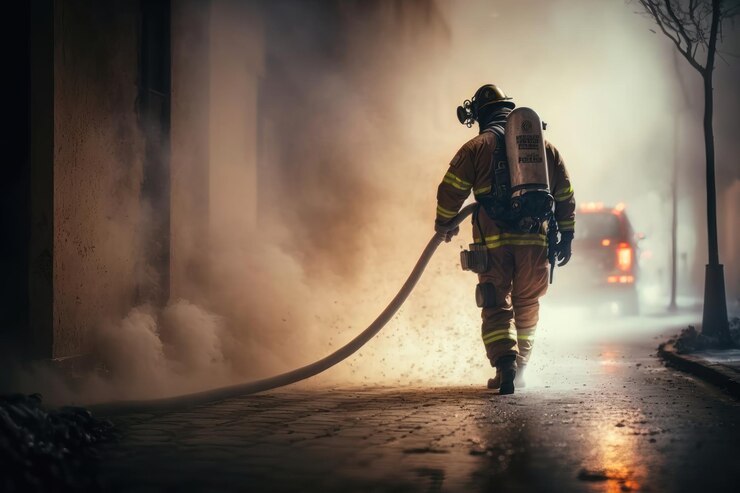Aqueous film-forming foams (AFFF) contain per- and polyfluoroalkyl substances (PFAS) that enable rapid suppression of flammable liquid fires. However, scientific evidence now reveals the damaging health impacts of AFFF exposure and community and environmental contamination risks.
Though critical for extinguishing blazes, these firefighting agents carry hidden, long-term public health costs that demand solutions.
In this blog post, we will analyze the current scientific data linking AFFF usage to adverse health outcomes. We will also highlight costs to firefighters and local governments and promote actions to reduce PFAS foam use.
The path forward requires open acknowledgment of trade-offs alongside accountability and advocacy to protect both our lives and livelihoods.
Quantifying the Impact: Financial and Social Costs of AFFF Usage
AFFF usage carries hidden costs beyond dumped fire sites. PFAS compounds are known to enter ecosystems and food chains, incurring extensive remediation needs. Moreover, their bioaccumulation in human bodies elevates the risk of numerous diseases.
According to TorHoerman Law, cancer has proven to be the most devastating outcome of PFAS exposure. The trend of testicular, kidney, and bladder cancer prevalence spiking among first responders is alarming.
The incidence of leukemia, lymphoma, and pancreatic cancer may also rise with exposure. Apart from physical suffering, families and veterans endure lost income, caregiving strains, reduced quality of life, and immeasurable grief from the premature loss of loved ones.
Additionally, children growing up in areas laden with PFAS contamination further face higher rates of neurodevelopmental issues, birth abnormalities, and stillbirths linked to passed-on PFAS concentrations.
A combination of these chemicals can disrupt children’s physiological processes, impacting both their lipid and protein pathways. They also risk interfering with their essential thyroid hormone regulation.
The tangible costs, like medical bills and reduced productivity, add up for those affected, giving companies and governments a push to prevent exposure risks.
Plus, it’s crucial to recognize and validate the suffering of victims. By changing community practices and policies, we can ensure toxic chemicals don’t sneak out of our protective systems again.
The Responsible Path Forward: Solutions and Healing
Several interventions offer the promise of improving outcomes while upholding emergency response efficacy.
The legislation now restricts PFAS in foams, with bans in several states, and the Department of Defense directives are also in place to restrict their use. Responsible procurement incentives and community right-to-know laws further enhance accountability.
For individuals already affected, options include enrolling in the FEMA Firefighter Cancer Support Network, which provides resources and guidance for prevention and diagnosis, along with peer support to combat stigma.
Legal advocates also increasingly facilitate firefighter foam cash settlements through litigation against manufacturers while tracking policy shifts governing disability claim eligibility.
All parties need to work together to put safety measures in place. This includes providing proper protective gear, making warnings about exposure, and monitoring health. While it’s important to switch to safer alternatives, following usage guidelines and supporting victims also help reduce harm in the meantime.
Heeding Early Warnings
Initial evidence linking PFAS exposure to health issues emerged over 20 years ago, yet unchecked widespread AFFF use continued. Manufacturers downplaying risks while profiting off government contracts bear partial blame. However, the interagency failure to investigate firefighter cancer clusters and environmental contamination near airfields proved negligent.
Now, the EPA administers a voluntary phase-out of legacy AFFFs. But without financial incentives or mandates, most fire departments hesitate to absorb transition costs despite safer fluorine-free alternatives meeting key performance metrics.
Political leaders must spur public-private collaboration towards affordable, non-toxic technologies before PFAS flows unchecked into more communities leaving a wake of illness and devastation. We ignored warnings before – we cannot afford inaction again.
From Smoke to Transparency: Building a Healthier Future for Firefighters
Transitioning from toxic to sustainable firefighting represents no small feat given the demanding performance specifications. Promising innovations like non-fluorinated foams and silicone-based gels are slowly coming to the forefront.
These alternatives might not match the efficacy of toxic PFAS compounds, but they are being promoted for their environmentally friendly nature.
Several of these innovations are now eligible for military approval, fulfilling important criteria like the burn-back resistance tests. This progress enhances fire suppression capabilities while reducing reliance on PFAS-based foams.
The conversation continues to gain momentum as word spreads of viable options and liability risks mount against chemical producers.
Firefighters, the companies making the equipment, and the people in charge of safety rules, all need to be on the same page. It’s been way too long; let’s work together to find safer ways to fight fires that don’t come at such a high cost.
Positive change remains possible, but only through transparency, accountability, and a refusal to accept the status quo when people’s lives hang in the balance. The road ahead will not prove easy, yet traveling it together with compassion and conviction can build a future where heroism in crisis carries no hidden costs.







Leave feedback about this